Spatio-Temporal Differentiation of Urban-Rural Equalized Development at the County Level in Chengdu
Abstract
:1. Introduction
2. Materials and Methods
2.1. About Chengdu
2.2. Data Resources
2.3. Evaluating Indicator System and Methodology
2.3.1. Establishment of an Appraisal Indicator System of URED
2.3.2. Methodology
3. Results and Discussion
3.1. Evaluation of URED
3.1.1. Factor Identification for Evaluation of URED
3.1.2. Spatio-Temporal Patterns of URED
3.2. Dynamic Degree of URED
3.2.1. Dynamic Degree of URED during 2004–2007
3.2.2. Dynamic Degree of URED during 2007–2010
3.2.3. Dynamic Degree of URED during 2010–2013
3.3. Strategy to Promote URED
4. Conclusions
Acknowledgments
Author Contributions
Conflicts of Interest
References
- James, T.M. The socio-spatial dynamics of development: Geographical insights beyond the 2009 World Development Report. Camb. J. Reg. Econ. Soc. 2011, 4, 175–188. [Google Scholar]
- Gao, Z. Development path of urban-rural integration. Asian Agric. Res. 2012, 4, 53–89. [Google Scholar]
- Liu, Y.S.; Lu, S.S.; Chen, Y.F. Spatio-temporal change of urban–rural equalized development patterns in China and its driving factors. J. Rural Stud. 2013, 32, 320–330. [Google Scholar] [CrossRef]
- Yu, A.T.W.; Wu, Y.Z.; Zheng, B.B.; Zhang, X.L.; Shen, L.Y. Identifying risk factors of urban-rural conflict in urbanization: A case of China. Habitat Int. 2014, 44, 177–185. [Google Scholar] [CrossRef]
- Li, Y.H.; Hu, Z.C. Approaching Integrated Urban-Rural Development in China: The Changing Institutional Roles. Sustainability 2015, 6, 7031–7048. [Google Scholar] [CrossRef]
- André, T.; Frédéric, W. Towards New Paths for Regional and Territorial Development in Rural Areas. Eur. Plan. Stud. 2015, 23, 650–677. [Google Scholar]
- Tong, G.J.; Wang, T.K. The Estimated and Assessed Study on Urban-Rural Integration Course in Northeast China. In Future Wireless Networks and Information Systems; Springer: Berlin, Heidelberg, Germany, 2015; Volume 144, pp. 637–644. [Google Scholar]
- Su, C.W.; Liu, T.Y.; Chang, H.L.; Jiang, X.Z. Is urbanization narrowing the urban-rural income gap? A cross-regional study of China. Habitat Int. 2015, 48, 79–86. [Google Scholar] [CrossRef]
- Wang, J.G.; Wang, X.P. New urbanization: A new vision of China’s urban–rural development and planning. Frontiers of Architectural Research. 2015, 4, 166–168. [Google Scholar] [CrossRef]
- Afridi, F.; Li, S.X.; Ren, Y.F. Social identity and inequality: The impact of China’s hukou system. J. Public Econ. 2015, 123, 17–29. [Google Scholar] [CrossRef]
- Li, Y.H. Urban–rural interaction patterns and dynamic land use: Implications for urban-rural integration in China. Reg. Environ Chang. 2012, 12, 803–812. [Google Scholar] [CrossRef]
- Liu, Z.Q. Institution and inequality: The hukou system in China. J. Comp. Econ. 2005, 33, 133–157. [Google Scholar] [CrossRef]
- Chen, Y.P.; Liu, M.; Zhang, Q. Development of financial intermediation and the dynamics of urban-rural disparity in China, 1978–1998. Reg. Stud. 2010, 44, 1171–1187. [Google Scholar] [CrossRef]
- Long, H.L.; Zou, J.; Jessica, P.; Li, Y.R. Analysis of rural transformation development in China since the turn of the new millennium. Appl. Geogr. 2011, 31, 1094–1105. [Google Scholar] [CrossRef]
- Li, M.N.; Han, X.P. Financing Problems in China’s Rural Areas. J. Northeast Agric. Univ. (Engl. Ed.) 2014, 21, 80–89. [Google Scholar]
- Zhang, X.Y. Two Sessions Observation: 0.9 million Villages have Disappeared in Ten Years and Ancient Villages Need Urgent Protection in China. Available online: http://china.huanqiu.com/hot/2015-03/5878357.html (accessed on 11 May 2015). (In Chinese)
- Hayashi, T. Measuring rural–urban disparity with the Genuine Progress Indicator: A case study in Japan. Ecol. Econ. 2015, 120, 260–271. [Google Scholar] [CrossRef]
- Dai, H.J.; Sun, T.; Zhang, K.; Guo, W. Research on rural nonpoint source pollution in the process of urban-rural integration in the economically-developed area in China based on the improved STIRPAT model. Sustainability 2015, 7, 782–793. [Google Scholar] [CrossRef]
- Huang, L.; Yan, L.J.; Wu, J.G. Assessing urban sustainability of Chinese megacities: 35 years after the economic reform and open-door policy. Landsc. Urban Plan. 2016, 145, 57–70. [Google Scholar] [CrossRef]
- Liu, Y.S.; Wang, L.J.; Long, H.L. Spatio-temporal analysis of land-use conversion in the eastern coastal China during 1996–2005. J. Geogr. Sci. 2008, 18, 274–282. [Google Scholar] [CrossRef]
- Zhai, R.X.; Liu, Y.S. Dynamic evolvement of agriculture system and typical patterns of modern agriculture in coastal China: A case of Suzhou. Chin. Geogr. Sci. 2009, 19, 249–257. [Google Scholar] [CrossRef]
- Svein, T. Urban-rural Interrelationship: Conditions for sustainable Development. In Proceedings of the 2nd FIG Regional Conference, Marrakech, Morocco, 2–5 December 2003.
- Long, H.L.; Liu, Y.S.; Li, X.B.; Chen, Y.F. Building new countryside in China: A geographical perspective. Land Use Policy 2010, 27, 457–470. [Google Scholar] [CrossRef]
- Pablo, G. Ecosystem services: Foundations for a new rural–urban compact. Ecol. Econ. 2007, 62, 383–387. [Google Scholar]
- Xue, D.S.; Huang, G.Z.; Guan, J.W.; Lin, J.R. Changing concepts of city and urban planning practices in Guangzhou (1949–2010): An approach to sustainable urban development. Chin. Geogr. Sci. 2014, 24, 607–619. [Google Scholar] [CrossRef]
- Li, P.; Liu, S.Q.; Sun, L. Spatial-temporal changes of rurality driven by urbanization and industrialization: A case study of the Three Gorges Reservoir Area in Chongqing, China. Habitat Int. 2016, 51, 124–132. [Google Scholar]
- Kawka, R. Growth and Innovation through Urban-Rural Partnership. In Guiding Principles for Spatial Development in Germany; Springer: Heidelberg, Germany, 2009; pp. 1–17. [Google Scholar]
- Partridge, M.D.; Ali, K.; Olfert, M.R. Rural-to-Urban Commuting: Three Degrees of Integration. Growth Chang. 2010, 41, 303–335. [Google Scholar] [CrossRef]
- Horlings, L.G.; Kanemasu, Y. Sustainable development and policies in rural regions; insights from the Shetland Islands. Land Use Policy 2015, 49, 310–321. [Google Scholar] [CrossRef]
- Palmisano, G.O.; Govindan, K.; Loisi, R.V.; Sasso, P.D.; Roma, R. Greenways for rural sustainable development: An integration between geographic information systems and group analytic hierarchy process. Land Use Policy 2016, 50, 429–440. [Google Scholar] [CrossRef]
- Zhang, X.; Wu, Y.; Skitmore, M.; Jiang, S. Sustainable infrastructure projects in balancing urban–rural development: Towards the goal of efficiency and equity. J. Clean. Prod. 2014, 107, 445–454. [Google Scholar] [CrossRef]
- Tang, Y.; Mason, R.J.; Wang, Y. Governments’ functions in the process of integrated consolidation and allocation of rural–urban construction land in China. J. Rural Stud. 2015, 42, 43–51. [Google Scholar] [CrossRef]
- Hong, Y.X. Integrated Urban-Rural Development. In The China Path to Economic Transition and Development; Springer Science & Business Media: Gateway East, Singapore, 2016; pp. 151–169. [Google Scholar]
- Chen, A.M.; Gao, J. Urbanization in China and the coordinate development model-the case of Chengdu. Soc. Sci. J. 2011, 48, 500–513. [Google Scholar] [CrossRef]
- Shen, L.Y.; Jiang, S.J.; Yuan, H.P. Critical indicators for assessing the contribution of infrastructure projects to coordinated urban–rural development in China. Habitat Int. 2012, 36, 237–246. [Google Scholar] [CrossRef]
- Jiang, S.J.; Shen, L.Y.; Zhou, L. Empirical Study on the Contribution of Infrastructure to the Coordinated Development between Urban and Rural Areas: Case Study on Water Supply Projects. Procedia Environ. Sci. 2011, 11, 1113–1118. [Google Scholar]
- Long, H.L.; Zou, J.; Liu, Y.S. Differentiation of rural development driven by industrialization and urbanization in eastern coastal China. Habitat Int. 2009, 33, 454–462. [Google Scholar] [CrossRef]
- Li, K.; Yang, Q.J. Research of property rights institution in ChengDu’s urban-rural integration development: A case study. Procedia Eng. 2011, 21, 700–706. [Google Scholar]
- Zhong, Z.; Guang, Y. Study on the machanism evolution of China’s urban-rural integration development planning and its land system in practice. Energy Procedia 2011, 5, 1852–1858. [Google Scholar] [CrossRef]
- Tang, Y.; Mason, R.J.; Sun, P. Interest distribution in the process of coordination of urban and rural construction land in China. Habitat Int. 2012, 36, 388–395. [Google Scholar] [CrossRef]
- Liu, Y.S.; Cheng, C.; Li, Y.R. Differentiation regularity of urban-rural equalized development at prefecture-level city in China. J. Geogr. Sci. 2015, 25, 1075–1088. [Google Scholar] [CrossRef]
- Liu, Y.S.; Wang, G.G.; Zhang, F.G. Spatial-temporal dynamic patterns of rural area development in eastern coastal China. Chin. Geogr.Sci. 2013, 23, 173–181. [Google Scholar] [CrossRef]
- Kaiser, H.F. An index of factorial simplicity. Psychometrika 1974, 39, 31–36. [Google Scholar] [CrossRef]
- Liu, Y.S.; Hu, Z.C.; Li, Y.H. Process and cause of urban-rural development transformation in the Bohai Rim Region, China. Integral Transform. Spec. Funct. 2014, 24, 1147–1160. [Google Scholar] [CrossRef]
- Jiao, B.F.; Lin, D.; Peng, J.N. The New Construction and Application of the Estimation System of Urban and Rural Integration--The Estimation of Urban and Rural Integration in Yangtze River Delta Area. FUDAN J. (Soc. Sci.) 2010, 4, 75–83. (In Chinese) [Google Scholar]
- Huang, S.L.; Wong, J.H.; Chen, T.C. A framework of indicator system for measuring Taipei’s urban sustainability. Landsc. Urban Plan. 1998, 42, 15–27. [Google Scholar] [CrossRef]
- Gu, Y.K.; Xu, Y.J. Study on evaluation index system of urban and rural integration. Zhejiang Soc. Sci. 2004, 6, 95–99. (In Chinese) [Google Scholar]
- Zhao, J.J.; Chai, L.H. A novel approach for urbanization level evaluation based on information entropy principle: A case of Beijing. Phys. A: Stat. Mech. Appl. 2015, 430, 114–125. [Google Scholar] [CrossRef]
- Du, Q.Y.; Wang, Y.X.; Ren, F.; Zhao, Z.Y.; Liu, H.Q.; Wu, C.; Li, L.J.; Shen, Y.R. Measuring and Analysis of Urban Competitiveness of Chinese Provincial Capitals in 2010 under the Constraints of Major Function-Oriented Zoning Utilizing Spatial Analysis. Sustainability 2014, 6, 3374–3399. [Google Scholar] [CrossRef]
- Ye, Y.M.; Richard, L.; Qin, B. Coordinated Urban-Rural Development Planning in China. J. Am. Plan. Assoc. 2013, 79, 125–137. [Google Scholar] [CrossRef]
- Kew, B.; Lee, B.D. Measuring Sprawl across the Urban Rural Continuum Using an Amalgamated Sprawl Index. Sustainability 2013, 5, 1806–1828. [Google Scholar] [CrossRef]
- Cerreta, M.; Poli, G. A Complex Values Map of Marginal Urban Landscapes: An Experiment in Naples (Italy). Int. J. Agric. Environ. Inf. Syst. 2013, 4, 41–62. [Google Scholar] [CrossRef]
- Verburg, P.H.; Schot, P.P.; Dijst, M.J.; Veldkamp, A. Land use change modelling: Current practice and research priorities. Geojournal 2004, 61, 309–324. [Google Scholar] [CrossRef]
- Romano, B.; Zullo, F. The urban transformation of Italy’s Adriatic coastal strip: Fifty years of unsustainability. Land Use Policy 2014, 38, 26–36. [Google Scholar] [CrossRef]
- Jantz, C.A.; Goetz, S.J.; Shelley, M.K. Using the SLEUTH Urban Growth Model to Simulate the Impacts of Future Policy Scenarios on Urban Land Use in the Baltimore-Washington Metropolitan Area. Environ. Plan. B Plan. Des. 2004, 31, 251–271. [Google Scholar] [CrossRef]
- Amato, F.; Pontrandolfi, P.; Murgante, B. Supporting planning activities with the assessment and the prediction of urban sprawl using spatiotemporal analysis. Ecol. Inf. 2015, 30, 365–378. [Google Scholar] [CrossRef]
- Appiah, D.O.; Schröder, D.; Forkuo, E.K.; Bugri, J.T. Application of Geo-Information Techniques in Land Use and Land Cover Change Analysis in a Peri-Urban District of Ghana. ISPRS Int. J. Geo-Inf. 2015, 4, 1265–1289. [Google Scholar] [CrossRef]
- Foley, J.A.; Ruth, D.; Asner, G.P.; Barford, C.; Bonan, G.; Carpenter, S.R.; Chapin, F.S.; Coe, M.T.; Daily, G.C.; Holly, K.; et al. Global consequences of land use. Science 2005, 309, 570–574. [Google Scholar] [CrossRef] [PubMed]
- Martellozzo, F.; Clarke, K.C. Measuring urban sprawl, coalescence, and dispersal: A case study of Pordenone, Italy. Environ Plan. B Plan. Des. 2011, 38, 1085–1104. [Google Scholar] [CrossRef]
- Grimmond, S. Urbanization and global environmental change:local effects of urban warming. Geogr. J. 2007, 173, 83–88. [Google Scholar] [CrossRef]
- Amato, F.; Maimone, B.A.; Martellozzo, F.; Nolè, G.; Murgante, B. The Effects of Urban Policies on the Development of Urban Area. Sustainability 2016. [Google Scholar] [CrossRef]
- Koomen, E.; Stillwill, J.; Bakema, A.; Scholten, H.J. Modelling Land-Use Change: Progress and Applications; Springer: Dordrecht, The Netherlands, 2007; pp. 234–318. [Google Scholar]
- Romano, B.; Zullo, F. Models of Urban Land Use in Europe: Assessment tools and criticalities. Int. J. Agric. Environ. Inf. Syst. 2014, 4, 80–97. [Google Scholar] [CrossRef]
- Ahmed, B.; Hasan, R.; Maniruzzaman, K.M. Urban Morphological Change Analysis of Dhaka City, Bangladesh, Using Space Syntax. ISPRS Int. J. Geo-Inf. 2014, 3, 1412–1444. [Google Scholar] [CrossRef]
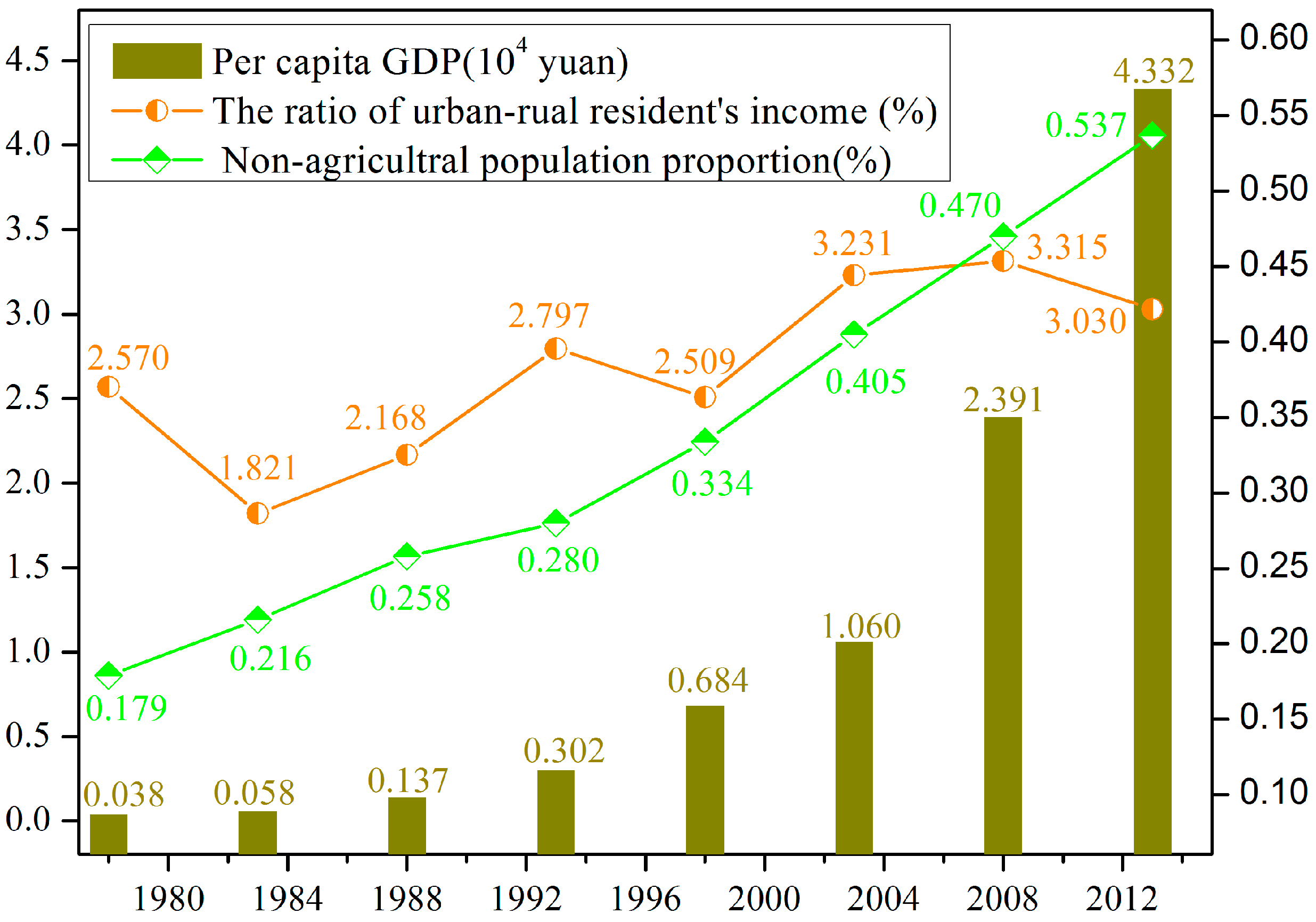
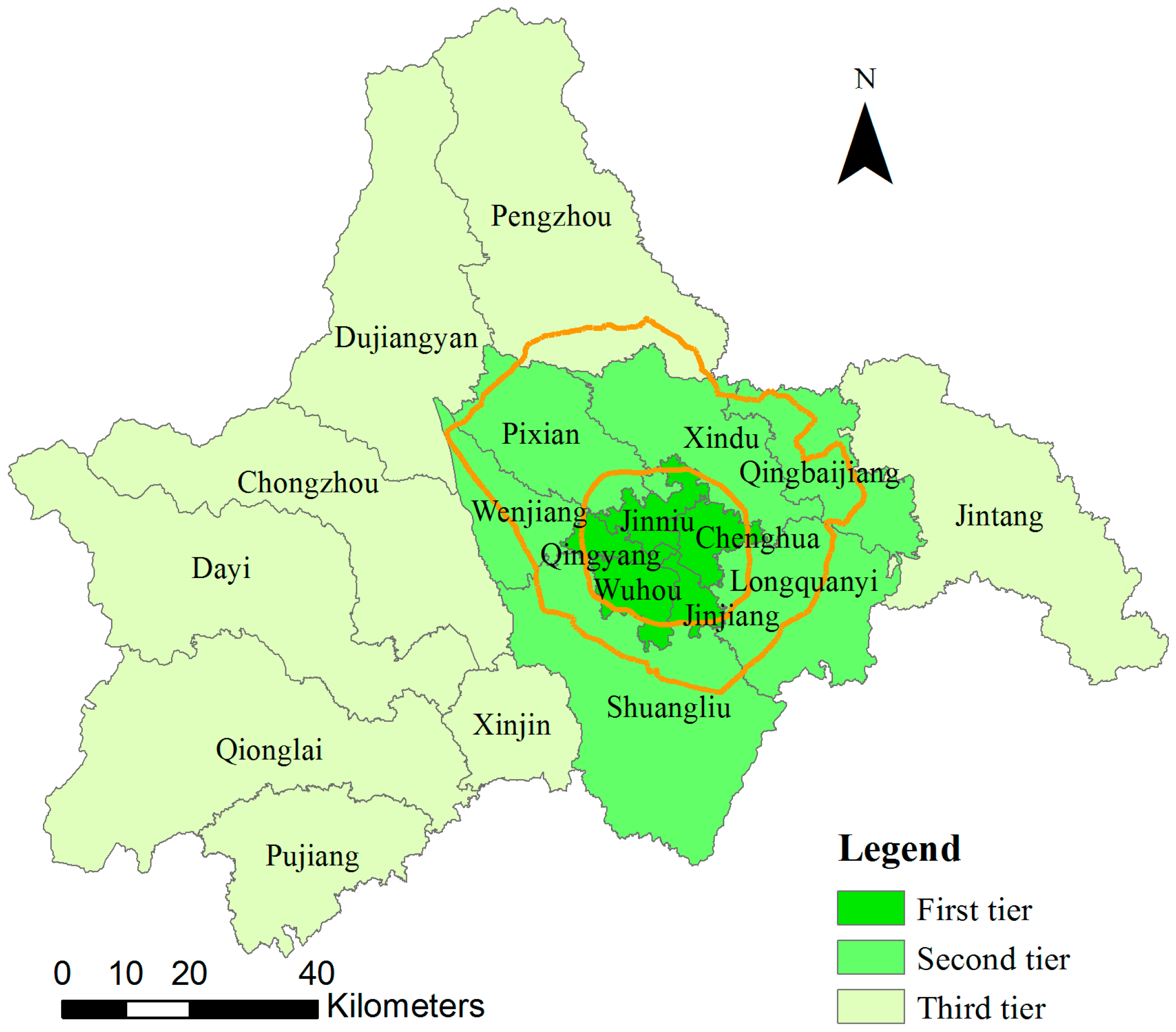
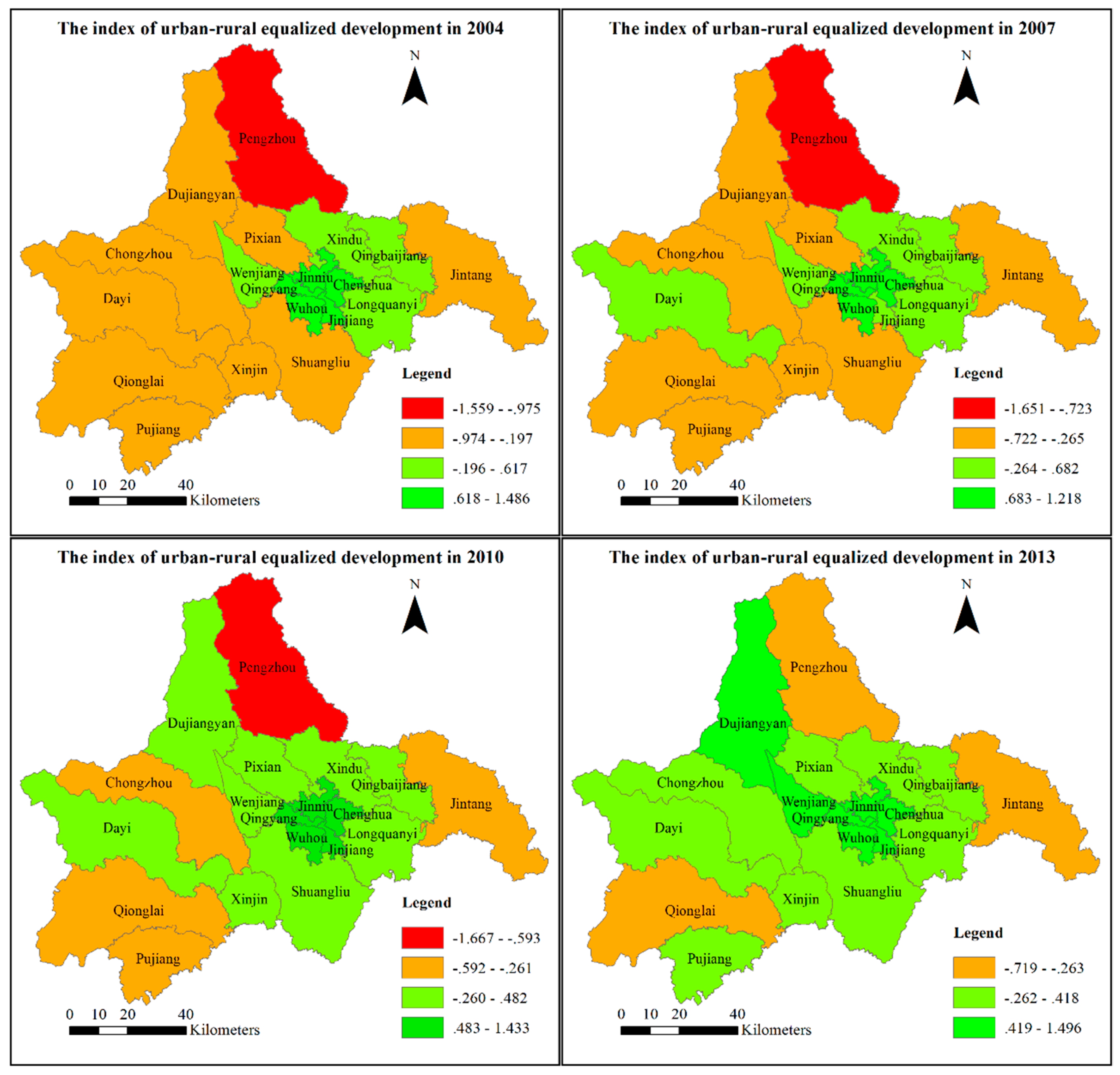
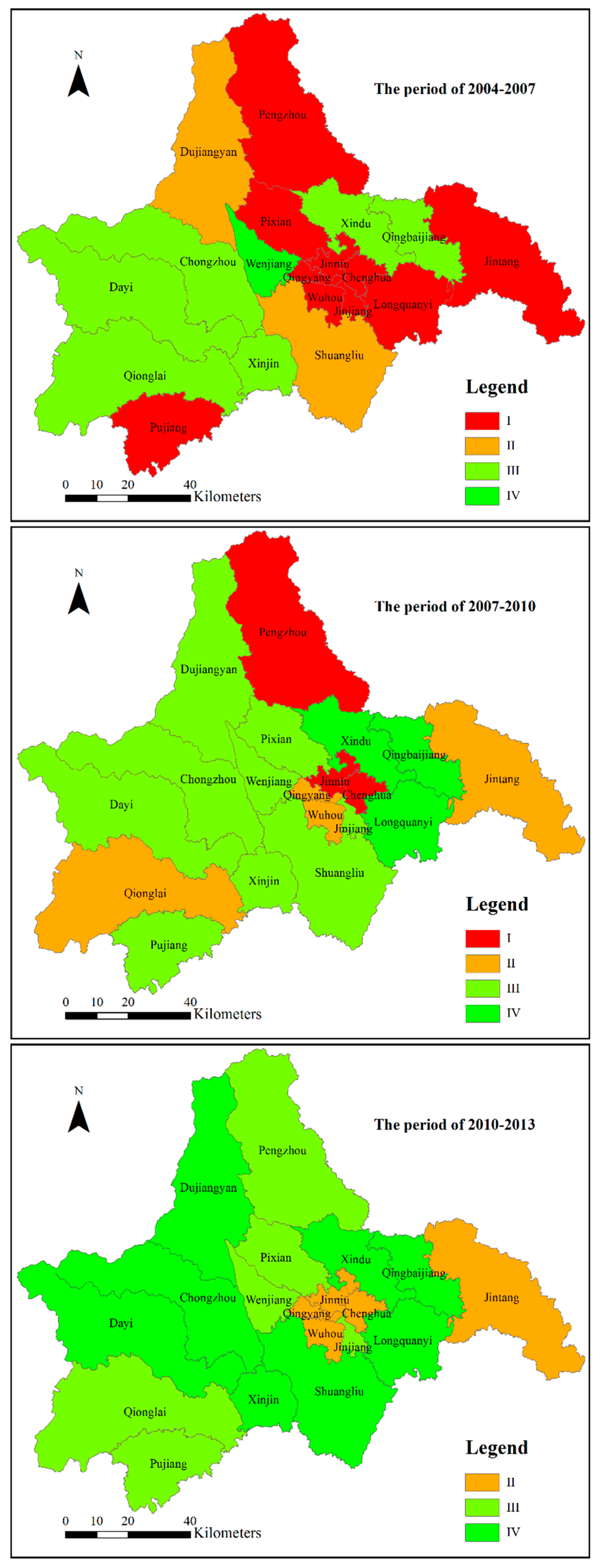

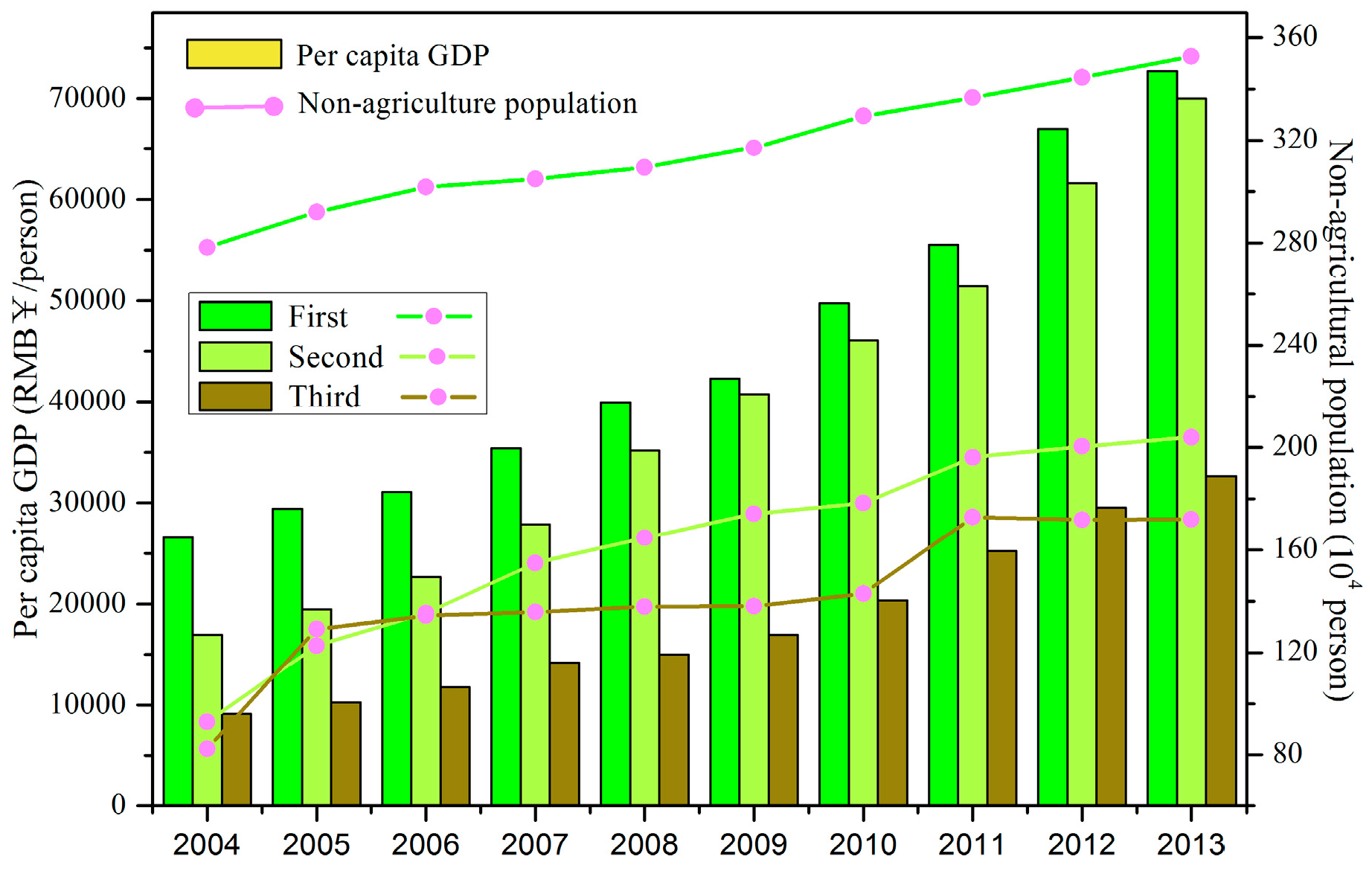
| Target Layer | Index Layer | Calculation Formula |
|---|---|---|
| Spatial allocation | Highway net density (km/km2) Non-agriculture population proportion (%) | Length of highway (km)/Area of land (km2) Non-agriculture population (104 person)/Total population at the year-end (104 person) |
| Community and village density (unit/km2) | Number of communities and villages (unit)/Area of land (km2) | |
| Per capita domestic product (GDP) (RMB104 yuan/person) | Gross Domestic Product (GDP) (RMB104 yuan )/ Population at the year-end (person) | |
| Percentage of rural non-farm payrolls (%) | Rural non-farm employed persons (104 persons)/Rural employed persons (104 persons) | |
| Economic development | Per capita fixed-asset investment (RMB104 yuan/person) | Total investment (RMB104 yuan)/Population at the year-end(person) |
| Per capita public-budgetary expenditure (RMB 104 yuan/person) | Total public-budgetary expenditure (RMB104 yuan)/ Population at the year-end (person) | |
| Index of urban-rural productivity of dual track structure (%) | where I is the index of urban-rural productivity of dual track structure; Va and Vb are the added value of the agriculture industry(RMB 104 yuan) and the added value of non-farm industry (RMB 104 yuan); Ea and Eb are the employed population of the agriculture industry and non-farm industry (104 persons) | |
| Average number of full-time teachers per each 100 Regular Secondary School students (person/102 persons) | Full time teachers (person)/Student enrolment of Regular Secondary school at the year-end (102 persons) | |
| Social services | Average number of hospital beds per 100 inhabitants (beds /102 persons) | Number of hospital beds (beds)/Population at the year-end (102 persons) |
| Persons receiving lowest cost-of-living per 100 inhabitants (person/102 persons) | Number of persons receiving lowest cost-of-living (person) /Population at the year-end (102 persons) | |
| Ratio of urban-rural residents’ income (%) x41 | Per capita net income of rural households (RMB yuan)/Per capita disposable income of urban households (RMB yuan) | |
| Life quality | Per capita retail sales of consumer goods (RMB104 yuan/person) | Total retail sales of consumer goods (RMB104 yuan )/ Population at the year-end (person) |
| Ratio of urban-rural residents’ consumption expenditure (%) | Per capita living expenditure of rural households (RMB yuan)/Per capita living expenditure of urban households (RMB yuan) | |
| Ecological | Consumption of chemical fertilizer (104 ton) | Amount of chemical fertilizer use (104 ton) |
| Environment | Per capita cultivated land area (mu/person) | Cultivated land area (mu)/Population at the year-end (person) |
| Green coverage rate of built-up area (%) | Green coverage areas (km2)/Built-up Areas (km2) |
| Component | Initial Eigenvalue | Rotation Sum of Squared Loading | ||||
|---|---|---|---|---|---|---|
| Total | % of Variance | Cumulative % | Total | % of Variance | Cumulative % | |
| I | 9.157 | 53.864 | 53.864 | 4.909 | 29.125 | 29.125 |
| II | 2.626 | 15.446 | 69.310 | 4.661 | 27.397 | 56.522 |
| III | 1.283 | 7.545 | 76.855 | 2.790 | 16.437 | 72.959 |
| IV | 0.851 | 5.006 | 81.861 | 1.564 | 8.902 | 81.861 |
| R | O2004 | C2004 | O2007 | C2007 | O2010 | C2010 | O2013 | C2013 |
|---|---|---|---|---|---|---|---|---|
| Jingjiang | 5 | I | 5 | II | 5 | I | 5 | I |
| Qingyang | 2 | I | 3 | I | 3 | I | 3 | I |
| Jinniu | 3 | I | 2 | I | 2 | I | 2 | I |
| Wuhou | 1 | I | 1 | I | 1 | I | 1 | I |
| Chenghua | 4 | I | 4 | I | 4 | I | 4 | I |
| Longquanyi | 7 | II | 10 | II | 8 | II | 10 | II |
| Qingbaijiang | 8 | II | 7 | II | 7 | II | 12 | II |
| Xindu | 9 | II | 8 | II | 9 | II | 11 | II |
| Wenjiang | 6 | II | 6 | II | 6 | II | 6 | I |
| Jintang | 15 | III | 16 | III | 17 | III | 18 | III |
| Shuangliu | 13 | III | 13 | III | 12 | II | 8 | II |
| Pixian | 16 | III | 17 | III | 13 | II | 15 | II |
| Dayi | 12 | III | 9 | II | 11 | II | 9 | II |
| Pujiang | 11 | III | 15 | III | 16 | III | 16 | II |
| Xinjin | 14 | III | 12 | III | 10 | II | 13 | II |
| Dujiangyan | 10 | III | 11 | III | 14 | II | 7 | I |
| Pengzhou | 19 | IV | 19 | IV | 19 | IV | 19 | III |
| Qionglai | 18 | III | 18 | III | 18 | III | 17 | III |
| Chongzhou | 17 | III | 14 | III | 15 | III | 14 | II |
© 2016 by the authors; licensee MDPI, Basel, Switzerland. This article is an open access article distributed under the terms and conditions of the Creative Commons Attribution (CC-BY) license (http://creativecommons.org/licenses/by/4.0/).
Share and Cite
Chen, D.; Wang, Y.; Ren, F.; Du, Q. Spatio-Temporal Differentiation of Urban-Rural Equalized Development at the County Level in Chengdu. Sustainability 2016, 8, 422. https://doi.org/10.3390/su8050422
Chen D, Wang Y, Ren F, Du Q. Spatio-Temporal Differentiation of Urban-Rural Equalized Development at the County Level in Chengdu. Sustainability. 2016; 8(5):422. https://doi.org/10.3390/su8050422
Chicago/Turabian StyleChen, Deng, Yanxia Wang, Fu Ren, and Qingyun Du. 2016. "Spatio-Temporal Differentiation of Urban-Rural Equalized Development at the County Level in Chengdu" Sustainability 8, no. 5: 422. https://doi.org/10.3390/su8050422
APA StyleChen, D., Wang, Y., Ren, F., & Du, Q. (2016). Spatio-Temporal Differentiation of Urban-Rural Equalized Development at the County Level in Chengdu. Sustainability, 8(5), 422. https://doi.org/10.3390/su8050422






